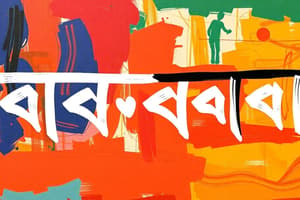Podcast
Questions and Answers
What is a key feature of the Bengali script?
What is a key feature of the Bengali script?
- It has roots in the Latin alphabet.
- It is a phonetic script.
- It is derived from the Brahmic family of scripts. (correct)
- It is primarily used for mathematical notation.
Which of the following is NOT a form found in Bengali literature?
Which of the following is NOT a form found in Bengali literature?
- Poetry
- Scientific journals (correct)
- Drama
- Prose
How is the Bengali language connected to Bengali culture?
How is the Bengali language connected to Bengali culture?
- It is primarily a written language without spoken use.
- It is disconnected from cultural expressions.
- It is integral to everyday communication and art. (correct)
- It is only used in academic settings.
What advantage does learning Bengali offer?
What advantage does learning Bengali offer?
Which statement accurately describes Bengali literature?
Which statement accurately describes Bengali literature?
What is the primary language spoken in Bangladesh?
What is the primary language spoken in Bangladesh?
Which of the following languages has significantly influenced the vocabulary of Bengali?
Which of the following languages has significantly influenced the vocabulary of Bengali?
Bengali is characterized by which of the following grammatical structures?
Bengali is characterized by which of the following grammatical structures?
What is a prominent feature of the Bengali vowel system?
What is a prominent feature of the Bengali vowel system?
When did a distinct Bengali literary tradition begin to emerge?
When did a distinct Bengali literary tradition begin to emerge?
What distinguishes Bengali as a synthetic language?
What distinguishes Bengali as a synthetic language?
Which aspect of Bengali vowel distinction is critical for meaning?
Which aspect of Bengali vowel distinction is critical for meaning?
The understanding of dialects in Bengali is important for which communication aspect?
The understanding of dialects in Bengali is important for which communication aspect?
Flashcards
Bengali language
Bengali language
A language from the Indo-Aryan family primarily spoken in Bangladesh and India.
Language evolution
Language evolution
The process of how a language changes over time, influenced by various factors.
Dialects
Dialects
Variations in pronunciation, grammar, and vocabulary within a language found in different regions.
Phonology
Phonology
Signup and view all the flashcards
Syntax
Syntax
Signup and view all the flashcards
Vocabulary
Vocabulary
Signup and view all the flashcards
Synthetic language
Synthetic language
Signup and view all the flashcards
SOV sentence structure
SOV sentence structure
Signup and view all the flashcards
Bengali Script
Bengali Script
Signup and view all the flashcards
Bengali Literature
Bengali Literature
Signup and view all the flashcards
Language and Culture in Bengal
Language and Culture in Bengal
Signup and view all the flashcards
Importance of Learning Bengali
Importance of Learning Bengali
Signup and view all the flashcards
Communication and Understanding
Communication and Understanding
Signup and view all the flashcards
Study Notes
Introduction
- Bengali is an Indo-Aryan language primarily spoken in Bangladesh and India.
- It's the official language of Bangladesh and one of the official languages of India.
- Bengali boasts a rich literary tradition, with a vast amount of literature.
- The language is widely used by a significant portion of the population in both countries.
History and Development
- Bengali's evolution spans centuries, shaped by numerous linguistic influences.
- Early forms trace back to Apabhramsa, a group of Middle Indo-Aryan languages.
- Key influences include Persian, Arabic, and Sanskrit.
- Modern Bengali is distinguished by its unique grammar and vocabulary.
- A significant Bengali literary tradition emerged by the 16th century.
Phonology
- Bengali has a relatively straightforward consonant and vowel system.
- The complex vowel system includes short, long vowels, and diphthongs.
- The consonant system comprises unaspirated and aspirated consonants.
- Vowel length significantly alters word meanings.
- Understanding Bengali phonology enhances pronunciation and articulation.
Grammar
- Bengali is a synthetic language with a complex system of grammatical cases and tenses.
- Nouns and adjectives don't always change form based on grammatical cases.
- The general sentence structure is largely Subject-Object-Verb (SOV).
- Demonstrative pronouns define proximity and distance.
- Verbs are conjugated to show tense, mood, and person. Polite verb forms exist.
Vocabulary
- Bengali heavily draws on Sanskrit for its vocabulary.
- Persian and Arabic have also contributed to Bengali's vocabulary.
- The language has words for a wide range of concepts.
- Bengali has absorbed terms from regional languages.
- Vocabulary constantly changes and evolves.
Dialects
- Regional dialects of Bengali exist, showcasing variations in pronunciation and grammar.
- These dialects are found in both Bangladesh and India.
- Differences in vocabulary, pronunciation, and sentence structure are notable.
- Understanding Bengali dialects is crucial for effective communication across regions.
Script
- Bengali utilizes a unique script derived from the Brahmic family.
- The script is widely used for writing Bengali.
- Mastery of the script necessitates studying and practice.
- The script's design is part of the language's cultural identity.
Literature
- Bengali literature has a lengthy and rich history.
- It contains diverse expressions, including poetry, prose, drama, and other writing styles.
- Notable literary figures and their literary works greatly impact Bengali culture and language.
- Bengali literature reflects the historical and social contexts of its creators.
Language and Culture
- Bengali language & culture are intrinsically linked.
- The language is used daily and in literature and art.
- Cultural events typically incorporate Bengali songs and spoken language.
- Stories, poems, and plays reveal aspects of cultural heritage and values.
Importance of Learning Bengali
- Learning Bengali unlocks access to a rich cultural legacy.
- Acquiring the language offers insights into the history, culture, and values of Bengali communities.
- Bengali language study facilitates communication and understanding with Bengali speakers.
- Proficiency in the language creates opportunities in areas such as translation, interpretation, and more.
Studying That Suits You
Use AI to generate personalized quizzes and flashcards to suit your learning preferences.
Description
This quiz explores the Bengali language, its history, and phonology. It covers the development of Bengali from early forms to its modern use and the significant literary tradition that has emerged over the centuries. Test your knowledge on the intricacies of this rich Indo-Aryan language!




